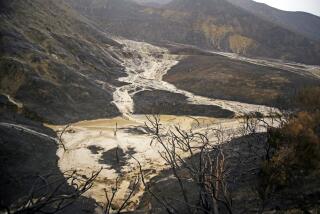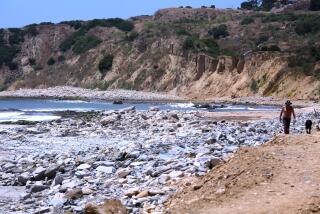Louisiana Tries to Reclaim Its Ever-Eroding Coastline
- Share via
PECAN ISLAND, La. — For this country town of hackberry forests and hunting lodges, devastation began with a few hungry cows.
Fifty years ago, a farmer decided to let his herd graze on a soggy plot of land he owned in Pecan Island, which is not really an island but a landlocked town resting perilously atop the marshes and bogs of southwest Louisiana. The cows ate the peat that covered the land. Without roots to hold it together, the soil underneath, little more than crushed oyster shells, crumbled. That left a nearby levee unprotected, so a storm wiped that out too.
Water rushed in. The farmer’s land became a tiny lake and, quietly, another piece of Louisiana washed away -- just a portion of the 1,900 square miles that have vanished since 1932.
Today, the land is being rebuilt. From a helicopter, a federal government ecologist, John Foret, watched as tractors built the last of 500 mud “terraces” to combat erosion. A $2.9-million project funded by the state and federal governments, it is one of 460 similar projects launched in Louisiana in the last 17 years costing a total of $400 million. And it is not enough.
“This part of the state,” said Foret, a project manager, “is dying.”
Convinced that those projects are merely buying Louisiana time, officials now have their sights set on the mother lode: They want to unleash the power of the Mississippi River in a final, massive undertaking to save their coast.
If Congress and the public buy Louisiana’s pitch that this is a national crisis -- as important to a schoolteacher in Idaho as to an oysterman in Pecan Island -- Louisiana plans to seek $14 billion from taxpayers for a project that could last 30 years.
“Nothing -- the Panama Canal, nothing -- will be as big as this,” said Jack C. Caldwell, secretary of the Louisiana Department of Natural Resources. “This will be the biggest engineering challenge ever undertaken.”
Though Louisiana has been fighting the problem for more than 70 years along the bulk of its wetland coast, state officials say time is of the essence. A football field’s area of land is lost every 38 minutes, according to the Department of Natural Resources, and another 500 square miles of land -- an area larger than the city of Los Angeles -- could be lost in the next 50 years if dramatic steps are not taken.
Already, erosion has exposed submerged pipelines, which have been struck by ships, resulting in oil spills. Entire communities are being swallowed by the Gulf of Mexico, Caldwell said. Louisiana accounts for almost a third of the seafood caught in the lower 48 states -- more than 1 billion pounds of fish and shellfish each year -- and prized fisheries are dying rapidly as marshes are flooded and the delicate balance of saltwater and freshwater is thrown off.
Gov. M.J. “Mike” Foster Jr., a Shreveport, La., native and an avid recreational fisherman, said he frequently uses a global positioning system to navigate the bayous and marshes of southern Louisiana. Though the technology is just a few years old, maps are frequently out of date because the coastline seems to change each day.
“The map says we’re on land, and we’re in 5 feet of water,” Foster said. “When I took office, we knew this was a problem. But I don’t think any of us really understood the magnitude of it.”
Mud and silt that washed down the Mississippi River over the last 10,000 years or so built up the area that is now southern Louisiana -- the lower quarter of the state, roughly, or most areas south of Interstate 10. Humans have managed to unravel that process in a matter of a century.
Government agencies, particularly the U.S. Army Corps of Engineers -- largely in an effort to spare communities along the Mississippi River from flooding and make navigation easier -- built hundreds of miles of levees and other protective barriers. Much of the river water is funneled into a canal that shoots far into the gulf, depriving Louisiana communities of the silt needed to sustain a fragile coast.
Global warming, which many scientists believe is causing the sea level to rise significantly, has compounded the problem, as have countless smaller operations, from oil drilling to the farmer’s decision to let his cows graze on a patch of marsh 50 years ago.
“Nature is just doing its thing,” Foret said. “We’re not helping.”
The most immediate battle is one of public relations.
Awareness of Louisiana’s plague pales in comparison to that of other areas that have received extensive attention and federal money, such as Chesapeake Bay and the Florida Everglades. The public sees those issues, the governor said, as “sexier” than Louisiana erosion.
The state and the Army Corps of Engineers are planning to go to Congress next year to lobby for an enormous, long-term allocation of federal money to address the erosion. Officials have begun arming themselves with evidence of the state’s plight -- and evidence this is an issue for the nation as well.
On the state level, they point out that the city of New Orleans is boxed in by erosion, leaving it dangerously exposed in the event of a large storm. The metropolitan area of 1.3 million people, one of the most storied cities in the South, contains many areas that lie below sea level.
The city is protected by a network of pumps and levees, but because of coastal erosion and tidal surges that are already increasing, that system could be overwhelmed by a large storm, leaving parts of New Orleans under as much as 18 feet of water, Caldwell said.
“I hate to even think about New Orleans,” he said. “If the big one hits, well, it’s a soup bowl.”
On the national level, Louisiana points to a number of thriving and critical industries. A quarter of the oil and natural gas consumed in the United States, for example, passes through Louisiana pipelines, an infrastructure in danger of collapse, officials said.
“There are major implications to the country -- to the country’s ability to protect itself, feed itself and warm itself,” Foster said. “This is a Louisiana problem. But it’s a national problem too.”
Louisiana officials have pieced together a $6-million, privately funded advertising blitz, an education campaign called America’s Wetland and a series of advertisements, which began appearing this month, many of them featuring the curious slogan “Don’t Be a Big Loser.”
The campaign is timed in part to steel the state for an October vote that is considered something of a referendum on Louisiana’s dedication to stemming the erosion.
Voters will weigh three state constitutional amendments, all of which would help finance projects designed to preserve the coast. One of the more controversial proposals would cap the amount of money plaintiffs can demand through lawsuits if they are damaged by coastal restoration projects; this year, a group of oyster fishermen won about $2 billion from juries who agreed their livelihoods had been destroyed by freshwater diversions -- some of the scores of projects designed to save the shore.
After the vote, Louisiana officials will prepare their march to Washington with a $14-billion restoration plan that would dwarf the $8-billion plan to rescue the Everglades from seven decades of abuse, draining and mismanagement.
Much of the money would go into the extensive and delicate engineering work required to unbridle the Mississippi River, allowing its silt to once again flow into southern Louisiana and rebuild barrier islands.
Well aware that theirs is an ambitious proposal, with an enormous price tag, Louisiana officials have begun spreading word of the state’s woes among Washington powerbrokers.
This summer, for instance, U.S. Sen. Mary Landrieu (D-La.) brought Sen. Pete V. Domenici (R-N.M.) on a tour to view the problems. Domenici, chairman of the Senate Energy and Natural Resources Committee -- a critical ally, potentially -- indicated that he would support some effort to route federal money to the region.
And Sen. John B. Breaux (D-La.) has conducted round-table discussions about the issue with leaders of numerous federal agencies, including the Defense Department, which would eventually be involved in a comprehensive coastal rescue effort.
Surprisingly, one of the toughest sales pitches in coming months will be made to the environmental community, which has been slow to sign on to the state’s plans. Some environmentalists remain skeptical of the involvement of corporate sponsors, including oil companies, in the education campaign. Others aren’t sure that government agencies long blamed for causing environmental harm should be entrusted with fixing it.
“There have been so many projects, and some of them have been disastrous,” said Donna LaFleur, a board member of the Baton Rouge, La., chapter of the National Audubon Society and a director at Louisiana Public Broadcasting, the state PBS affiliate. “I have some questions about all of this. But something has to be done.”
More to Read
Sign up for Essential California
The most important California stories and recommendations in your inbox every morning.
You may occasionally receive promotional content from the Los Angeles Times.











